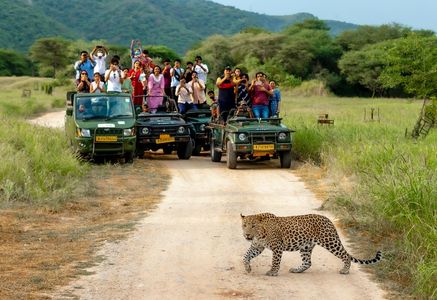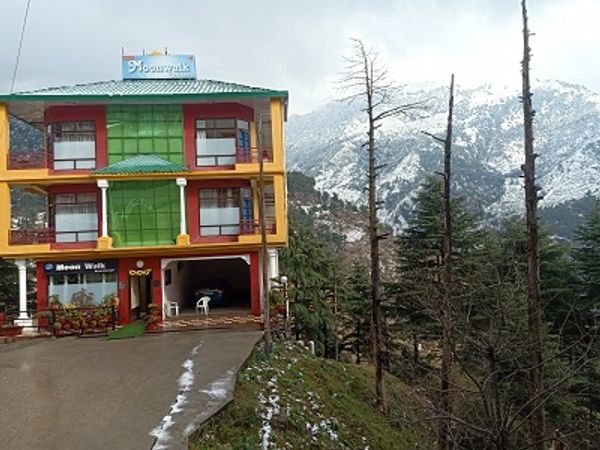Spots in the Shadows: The Thrill of Jhalana Leopard Safari
 Palakshi Meharwal
01 Aug, 2025
8 mins read
29
Palakshi Meharwal
01 Aug, 2025
8 mins read
29

Tucked within the rugged folds of the Aravalli hills in Jaipur lies a unique wilderness experience that’s often overshadowed by Rajasthan’s more famous landmarks. The Jhalana Leopard Safari—India’s first dedicated leopard reserve—offers an intimate and thrilling wildlife encounter that’s rapidly gaining recognition among nature lovers, wildlife photographers, and curious travelers. More than just a safari, Jhalana is a journey into the hidden heartbeat of the desert city.
A Wilderness Hidden in Plain Sight
While Jaipur bustles with palaces, markets, and architectural grandeur, Jhalana Reserve Forest, located just 10 kilometers from the city center, presents an unexpected contrast. Spanning nearly 23 square kilometers, this dry deciduous forest is a sanctuary for more than 30 leopards, including several cubs. Unlike larger parks where leopard sightings are often rare, Jhalana’s relatively small size and open terrain significantly increase the chances of spotting these elusive cats.
What makes Jhalana truly unique is the fact that this thriving wildlife zone exists so close to a major urban center. Visitors often find it fascinating how the wilderness coexists with city life, making the safari accessible for both planned excursions and spontaneous weekend getaways.
The Elusive Beauty of the Leopard
Leopards are among the most enigmatic and adaptive big cats in the world. Known for their stealth and solitary nature, they are masters at navigating rocky hills, thick undergrowth, and even human-inhabited areas. Jhalana’s leopards are no different—despite being apex predators, they are rarely heard and often only seen when they choose to reveal themselves.
One of the highlights of the Jhalana Safari is the thrill of unpredictability. Every drive is a new story. One might encounter a leopard resting lazily on a tree branch or observe one stalking its prey at dusk. Each sighting brings a blend of awe and adrenaline, and even seasoned travelers find themselves captivated by the silent power of these animals.
Beyond Leopards: A Thriving Biodiversity
While leopards are undoubtedly the star attraction, Jhalana Reserve is home to a diverse array of flora and fauna. Birdwatchers are in for a treat, with over 100 recorded bird species, including peacocks, shikras, white-eyed buzzards, and the occasional Indian eagle owl. The forest also hosts desert foxes, striped hyenas, blue bulls (nilgai), and Indian palm civets, creating a rich tapestry of desert wildlife.
Botanically, Jhalana is dominated by trees like dhok (Anogeissus pendula), salar, and kair, all of which are well adapted to the arid climate. These plants not only sustain the herbivores but also offer cover for predators, enabling the thrilling hide-and-seek dynamic that makes every safari ride exciting.
Safari Experience and What to Expect
Leopard Safaris in Jhalana are conducted in 4x4 open gypsy vehicles, typically accommodating up to six people. The reserve operates two safari slots daily—morning and evening—each lasting about two and a half hours. While the golden hours of sunrise and sunset are particularly photogenic, evening safaris often provide a higher likelihood of leopard sightings as the animals become more active.
Guides and drivers, most of whom are trained by the Forest Department, play a crucial role in enhancing the experience. Their knowledge of leopard movement, animal behavior, and forest trails can make the difference between a quiet drive and a truly memorable safari. It’s not uncommon for a sharp-eyed guide to spot a movement in the bushes that eventually leads to a full leopard sighting.
Conservation, Coexistence, and Challenges
The success of Jhalana Leopard Reserve is a testament to India’s growing efforts in urban wildlife conservation. Once a hunting ground for Jaipur royalty, the area has transformed into a safe haven for its native species. The Forest Department, in collaboration with local communities and eco-tourism stakeholders, has implemented measures to ensure minimal disturbance to wildlife while allowing controlled tourism.
Still, challenges persist. Urban expansion, noise pollution, and human-animal conflict pose ongoing threats. However, the presence of the reserve serves as a powerful educational tool, fostering awareness among locals and visitors alike about the importance of preserving these habitats.
Practical Tips for Visitors
Best Time to Visit:
The park remains open throughout the year, but the dry season (October to March) is ideal for comfortable weather and better visibility. Summer months (April to June) may offer higher chances of leopard sightings near water holes, although temperatures can soar.
Booking and Entry:
Safari bookings can be made online through the Rajasthan Forest Department’s official portal or via authorized tour operators. It’s advisable to book in advance, especially during weekends and peak tourist seasons.
What to Carry:
Binoculars, a DSLR or zoom-lens camera, sunblock, hats, and light clothing are recommended. While the park provides drinking water, it’s always wise to carry a personal bottle.
Code of Conduct:
As with all wildlife safaris, silence and patience are key. Avoid littering, making loud noises, or attempting to feed or disturb animals. Respecting the natural environment enhances your experience and supports conservation efforts.
Final Thoughts: Nature’s Secret in Jaipur’s Backyard
The Jhalana Leopard Safari is more than just a wildlife excursion—it’s a rare opportunity to connect with nature in a setting where the wild isn’t a distant dream but a real, tangible presence. For travelers seeking adventure with a dose of mystery and education, this experience offers a fresh perspective on urban conservation and the delicate balance between modernity and wilderness.
Written By:
Palakshi Meharwal



Hotels at your convenience
Now choose your stay according to your preference. From finding a place for your dream destination or a mere weekend getaway to business accommodations or brief stay, we have got you covered. Explore hotels as per your mood.


